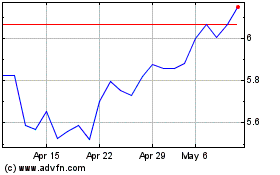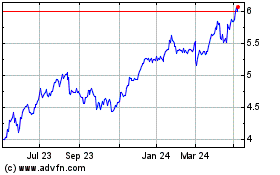Aegon CFO Says Approval of Solvency II Model Expected in December
November 12 2015 - 4:49AM
Dow Jones News
By Archie Van Riemsdijk
Dutch life insurer and pension provider Aegon expects the
country's regulator will give its approval in December for its
internal risk model to calculate its capital requirements under the
new regulatory framework Solvency II, after recent constructive
talks, the company's chief financial officer said.
Aegon didn't provide an update on its estimated range for its
solvency level under the new framework, ahead of the approval. "But
we have had very good conversations and the tone is good," chief
financial officer Darryl Button said in an interview with Dow Jones
Newswires on Thursday. "We therefore expect to receive approval in
December."
Aegon will wait until January to formally update investors on
its Solvency II level. The new regulatory framework will be in
force as of the start of next year.
At the time of its half-year earnings in August, Aegon lowered
its solvency guidance to a range of 140% to 170%, from 150% to 200%
previously. This caused a negative market reaction, with a drop in
Aegon's share price. Aegon also said it had recently submitted its
internal risk model for approval under the new regulatory
framework, known as Solvency II, which will replace the current
regulation next year.
Mr. Button also said the designation of Aegon as one of the nine
global systemically important insurance companies, or GSIIs, won't
be a binding constraint for the company. He said the status does
come with higher capital requirements, but those are well within
the current capital policy of Aegon, he said.
Aegon on Thursday reported a net loss of 524 million euros ($563
million) as a result of a book loss on selling its Canadian
insurance business.
Its IGD solvency ratio improved to 225%. This number measures
the ability of the insurance company to meet its future financial
obligations, even though it will soon become obsolete in the new
Solvency II framework.
IGD solvency improved due to positive spread developments for
Dutch mortgages.
At the company's U.S. operations, which generate most Aegon's
income, excess capital dropped to $600 million from $1 billion, due
to negative results from market-impact hedging.
Aegon's hedge "did not perform very well", Mr. Button conceded,
which caused a loss at the time when global stocks markets fell due
to market fears about decreasing Chinese economic growth. Due to a
yearly change of assumptions and models at the company, there was a
'hedging gap' which caused the loss, the CFO said. Lower excess
capital could potentially mean lower dividends for shareholders in
the future.
Write to Archie Van Riemsdijk at archieVan Riemsdijk.
Subscribe to WSJ: http://online.wsj.com?mod=djnwires
(END) Dow Jones Newswires
November 12, 2015 04:34 ET (09:34 GMT)
Copyright (c) 2015 Dow Jones & Company, Inc.
Aegon (EU:AGN)
Historical Stock Chart
From Mar 2024 to Apr 2024

Aegon (EU:AGN)
Historical Stock Chart
From Apr 2023 to Apr 2024
